On Canning, On Eating Locally, and On Why I Bother At All
It’s sort of interesting how some posts come about. Sometimes I very specifically know I want to try a recipe, I cook and photograph that recipe, edit the photos, write a little something, and post it to the world. Other times, something comes wildly out of left field and I MUST move it to top of my posting schedule (yes, I have one) because it will either lose relevance or because I’ve made some food I desperately want to share with you.
I had no intentions of writing about this, evidenced by the fact that I took not a single photo aside from before and after shots. This post arose out of a weekend in the kitchen what was, for lack of a better word, grueling. So grueling that it threatened to bring on a veritable identity crisis for this little food blogger.
Just in case you haven’t picked up on this, I care deeply about eating locally. I started this blog, in part, to chronicle my quest toward learning what that means and figuring out just how much of my diet I could change to local fare. This has involved shopping primarily at farmers markets, foregoing produce that isn’t seasonally available, avoiding chain restaurants, starting a garden, and learning the art and science of canning to capture produce when it’s plentiful so that I can eat locally all year long.
I’d say my experience with canning up to this weekend could be firmly classified in the “dabbling” realm. For a while I just made jam. There’s a reason that jam is widely considered an entry-level canning project. Couple together berries and sugar, boil the heck out of them, and you’re left with pretty little jars in brilliant shades of ruby and purple that taste delicious on everything from toast to ice cream. I’d graduated to making a few kinds of pickles, and I tried an inaugural batch of apple sauce last fall.
But none of those things are life-sustaining. They didn’t replace any staples that I was hitherto buying from the grocery store. I’d procured a water bath canner before my apple sauce project, and I knew I wanted to go further this summer. So this weekend, I took my first real crack at canning food that could potentially replace some store-bought staples with homemade ones.
Well.
Having selected eight recipes to try (if you’re gonna turn your kitchen upside down, you might as well get a lot done) I came home from the farmers market on Saturday morning well-stocked: two pounds of okra, five pounds of peaches, two quarts of figs, several onions and peppers, large handfuls both of parsley and basil, and, most importantly, nearly sixty pounds of tomatoes. I dug every every sizable pot and bowl from my cabinets and cheerfully set to work.
Several hours in, the boxes of tomatoes appeared to refill from some bottomless spring. Every burner on my stove was ablaze to keep pots boiling, jars sealing, and lids warm. Tomato juice was everywhere. My shoulders ached from running batch after batch of boiling tomatoes through a food mill, and my lower back was growing angrier by the second. With only half of the tomatoes in jars, I finally turned off the stove after twelve hours and collapsed into bed, exhausted at the thought of returning to the project the next day. But those tomatoes weren’t gonna can themselves, so Sunday morning I was back in the kitchen determined to empty those boxes. Seven hours later , I finally pulled the last batch of jars from the canner, hung up my apron, and tried to coax my muscles back from the ledge.
I stood back to admire my work, a little more than 33 pints of food, but I found I was asking myself a confusing question.
Why in the world am I doing this?
Not exactly the reaction I was expecting.
I figured I would come out of this weekend feeling euphoric. I had conquered a new jam! A new pickle! Two kinds of salsa! Ketchup! Tomato sauce, in three flavors! Instead, I not only felt physically exhausted, I felt utterly deflated. The way you feel when you discover the tooth fairy isn’t real, or when you finally get rejected after the final round of a job interview.
I was finally exposed, truly, to the immense quantities of produce required to create the likes of ketchup and thick, red pasta sauce. The ketchup alone required four pounds of tomatoes, FOUR, to yield one pint. And those four pounds of tomatoes took several hours to transform into this favorite condiment. (Respect those little packets, friends…)
Then there is the flavor. I’m not saying the final products taste bad. Maybe they don’t – to be honest, I haven’t cracked open a finished jar, and this is my first time making each of these recipes. But I did sample a spoonful here or a spoonful there to get a sense of what I was making and was surprised at what hit my tongue. The taste was so different (again, not bad, just different) from anything I’d had before I began to wonder: if this is what real tomato sauce tastes like, what the hell have I been eating all these years?
And finally, perhaps most importantly, there is the work. I’m rarely one to shy away from a productive day in the kitchen, but this weekend gave me a run for my money, especially when the yield seemed so very small for what I started with. I can totally see why farm families of yesteryear had so many children: imagine how much more rapidly I could blanch, peel, core, seed, chop, puree, cook, jar, and process sixty pounds of tomatoes with an army of my kin to help out.
For a gut-wrenching moment, just a moment, I wondered if my goals were folly. If all the energy I’ve put into taking local eating to the next level has been some futile, tilting-at-windmills sort of endeavor. Is my palette really so well-trained by massively processed food products that I can barely recognize that same staple when made from scratch? How long will it take me to anticipate the flavor of home-canned pasta sauce rather than that of the giant bottles of sauce we currently buy?
I started pondering just how far am I willing to go to eat locally. When I might be satisfied that my diet is local enough. There are some non-local ingredients that will simply never go away. Lemon juice, required even to make my tomato sauce, is a prime example. Olive oil is another. And I highly doubt I’ll give up chocolate, which isn’t even grown on this continent. Does eating these things up make me a hypocrite? And if it doesn’t, why not keep commercially produced salsa and pasta sauce, as well? To make it myself, I’d weathered the cost of the produce, the jars, the time… was it worth it?
Since then…
The apartment has cooled down, the smell of tomatoes has dissipated, and I’ve spent a lot of time contemplating the questions that flowed from my tomato-addled brain over the weekend. I always try to examine my actions, my emotions, my principals, and my reasons for doing things. On this particular matter, I came out pretty close to the same place I went in.
Why in the world am I doing this? Because it matters.
Local food is so much more than baskets of fresh strawberries in June. It’s more than meals at trendy restaurants, more than free-range eggs and grass-fed beef. It’s not about foregoing foods that are processed beyond their raw forms, but about garnering appreciation for the enormous effort and artistry that goes into creating them, which is where canning comes in. Canning fills my pantry with local food, supports local growers, capitalizes on the bounty of spring and summer produce, increases my self-reliance, and reduces packaging waste. Less of my food is coupled with weird-ass chemicals I can’t pronounce, and more of it stands against an industrial food system that is, in many ways, hugely unsustainable. Imagine what might change if each us learned to can.
Is it a lot of work? Absolutely. But for me, for my mission to eat locally, it is important work to do.
Next time, perhaps I’ll invite a friend so that the tomatoes chop twice as fast and I don’t awkwardly talk to myself. I’ll probably try some new recipes, repeat some favorites, and skip the ones I didn’t like. As the years go by, I’ll learn what is handy to have in my pantry: tomato sauce seasoned or plain? Whole tomatoes or diced ones? Maybe I’ll even advance to pressure canning to open up a whole new array of vegetables I can put up. The truth is I’ve only scratched the surface of this incredible craft, and I’m looking forward to digging deeper. In the meantime, I’ll get to enjoy the almost fifty pints of food neatly stacked in the pantry.
Who wants to join my zombie apocalypse team?

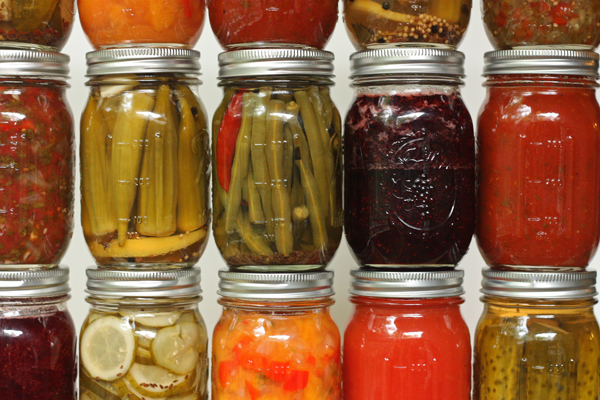

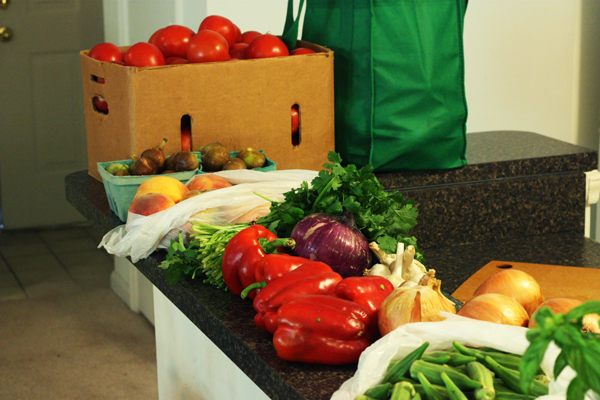
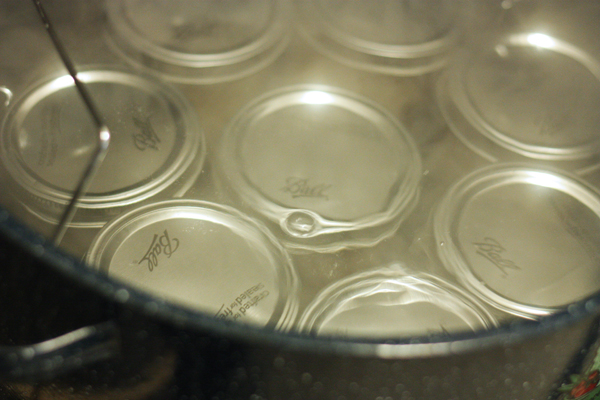
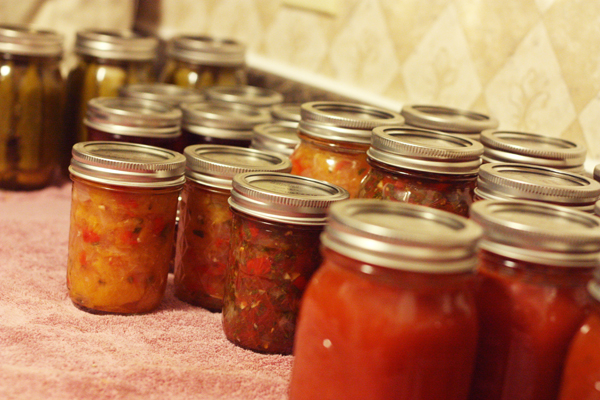
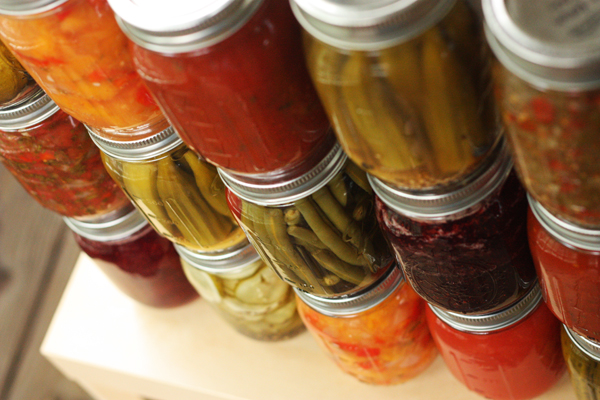
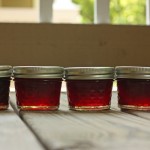
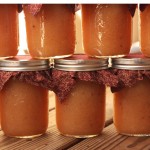

Teri
August 10, 2012 @ 12:08 pm
I go through this thing every year. However, when I run out of pantry sauce or chopped tomatoes and have to purchase them the answer is quite clear. There is absolutely no taste to the over processed cans with unripe chucks of fruit filled with to much salt and strange preservatives.
I know the that food I put up was grow with out chemicals and is much healthier for my family and the planet to boot. Kudos to you!
I love your website
Kristi @ 30 Pounds of Apples
August 10, 2012 @ 12:14 pm
I’m glad to hear it’s not just me. I’m looking forward to actually using some of these things to see how they compare (or rather, surpass the storebought!). Thanks for reading, and for sharing :)
Katie
August 10, 2012 @ 2:50 pm
Great article, Kristi. It’s refreshing to hear someone take an honest look at eating local. You’re right that it’s not all freshly picked strawberries – sometimes it’s a whole lot of work. I think everyone needs to find their own level of commitment without driving themselves crazy, but awareness is a big step in the right direction. Knowing that I can’t get locally-grown grapefruit in Boston can help me think of grapefruit as a luxury. Anyway, hope you enjoy the product of all your hard work!
Kristi @ 30 Pounds of Apples
August 15, 2012 @ 10:45 pm
Oh, I too loooooove me some grapefruit. I only buy it once or twice a year in its peak season, but oh how I savor it. I visited a friend in Phoenix and bought some locally grown and nearly died of happiness.
Eileen
August 10, 2012 @ 3:33 pm
This kind of discouragement is why I try to break up my preserving into more manageable small batches. It’s tough to work your way through bushels and bushels of veg all at once. I like to just make one thing at a time, even if I make lots of it. 20 or 30 pounds of tomatoes is plenty to take on in one weekend–you can do the pickles or beans or what have you the next weekend. :) And working with a friend is definitely a great plan!
I also find that the palate change comes on much more quickly than you might expect. I can taste the preservatives and artificial flavors in canned tomato sauces now–and that makes me even more determined to make my own.
Kristi @ 30 Pounds of Apples
August 15, 2012 @ 10:47 pm
I’m on the fence about breaking it up. On one hand, it would make it way less stressful to avoid those long days. On the other, its so much for affordable for me to buy a box of tomatoes in bulk than a few pints at a time from local vendors. I may, however, not try to add on other projects on tomato days… the pickles and fig jam could easily have waited a week!
Kelekona
May 17, 2013 @ 7:06 pm
I’ve skinned and froze tomatoes, so perhaps that could be part of the trick. All freezing does is burst the cell walls and allow very slow degradation, so skinning and freezing huge bushels in easily-manageable chunks will allow you to work just one batch at a time and get them canned.
If you believe freezers are going to go away, I believe that community women’s circles will come back.
Nancy W
August 11, 2012 @ 9:31 pm
Love your post! I picked peaches this week and spent the whole day today canning them. Made spiced peaches, peach pie filling and anawesome peach lavender jam. Exhausted but love the addition to my pantry. I will certainly enjoy them all this winter!
Kristi @ 30 Pounds of Apples
August 15, 2012 @ 10:44 pm
How lovely! Good peaches are few and far between in my area… that peach lavendar jam sounds fantastic!
Suzy
August 11, 2012 @ 10:23 pm
I love your blog, this post,…….and you!
Jenn
December 3, 2012 @ 12:09 pm
Great post Kristi! I’ve been making pickles for 3 years now – bought at the farmer’s market. It took a few hours to can 15 lbs of them, I can’t imagine how you did all these! I just decided to branch out this weekend and tried orange marmalade (failed) and then lemon curd because I have 4 lemons leftover (success). I will be trying more and more and hopefully be ready to can other things in addition to pickles by the time the next farmer’s market comes around.
Kristi @ 30 Pounds of Apples
December 3, 2012 @ 8:32 pm
Thanks Jenn! I also tried my first batch of marmalade this weekend (though it was a cranberry marmalade, so a bit of a ease into the real thing). I can’t wait to pop open a jar and see how it turns out. I think failure is part of the process, I’ve certainly had some myself!